|
Owl |
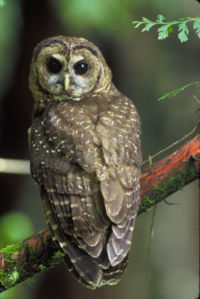
Northern Spotted Owl
|
|
Scientific classification |
| Kingdom: |
Animalia
|
| Phylum: |
Chordata
|
| Class: |
Aves
|
| Order: |
Strigiformes
Wagler, 1830 |
|
| Families |
Strigidae
Tytonidae |
The owl is a solitary, mainly
nocturnal
bird of prey. Owls belong to the
order Strigiformes, in which there are 222 known
species. Owls mostly hunt small mammals, insects, and other
birds, though a few species specialize in hunting
fish. They are found in all regions of the Earth except
Antarctica, most of Greenland, and some remote islands.
Though owls are typically solitary, the literary collective
noun for a group of owls is a parliament.
Owls are classified in two families: the
typical owls, Strigidae, and the
barn owls, Tytonidae.
External appearance
Owls have large forward-facing eyes and ears, a
hawk-like
beak, and usually a conspicuous circle of feathers
around each eye called a facial disc. Although owls
have
binocular vision, their large eyes are fixed in their
sockets, as with other birds, and they must turn their
entire head to change views.
Owls are far-sighted, and are unable to clearly see
anything within a few inches of their eyes. Their far
vision, particularly in low light, is incredibly good, and
they can turn their head 270 degrees around.
Different species of owls make different sounds. The
facial disc helps to funnel the sound of prey to their ears.
In some species, these are placed asymmetrically, for better
directional location.
Owls are more closely related to the
nightjars (Caprimulgiformes) than to the diurnal
predators in the order Falconiformes. Some taxonomists place
the nightjars in the same order as owls, as in the Sibley-Ahlquist
taxonomy .
Behaviour
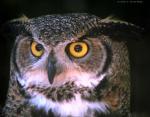
A
horned owl, genus Bubo.
Owls' powerful clawed feet and sharp beak enable them to
tear their prey to pieces before eating, although most items
are swallowed whole. Their muffled wings and dull feathers
allow them to fly practically silent and unseen. Some
fish-eating owls, which have no need of silence, lack this
adaptation.
Scientists studying the diets of owls are helped by their
habit of disgorging the indigestible parts of their prey
(bones, scales, fur, etc.) in the form of
pellets. These "owl pellets" are often sold by companies
to schools to be dissected by students as a lesson in
biology and ecology, because they are plentiful and easy to
interpret.
Owl eggs are white and almost spherical, and range in
number from a few to a dozen dependent on species. Their
nests are crudely built and may be in trees, underground
burrows or barns and caves.
Most owls are nocturnal, but several, including the
pygmy owls (Glaucidium), are crepuscular, or twilight
active, hunting mainly at dawn and dusk. A few owls, such as
the Burrowing Owl (Speotyto cunicularia) and the Short-eared
Owl (Asio flammeus), are also active
during the day.
The smallest owls include the pygmy owls, some of which
are only 13 cm (5.1 in) long, have a 32 cm (12.6-in)
wingspan, and weigh only 50 g (1.76 oz). The largest owls
are the
eagle owls, the Eurasian Eagle Owl Bubo bubo and Verreaux's
Eagle Owl B. lacteus, which may reach
76.2 cm (30 in) long, have a wingspan of just over 2 m (6.6
ft), and weigh about 4 kg (almost 9 lb).
Myth, lore, and popular culture
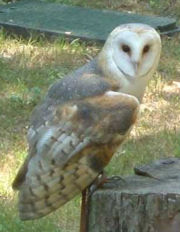
A
Barn Owl, Tyto alba.
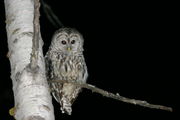
A
Barred Owl, Strix varia.
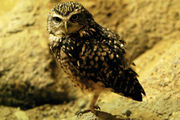
A
Burrowing Owl, Athene cunicularia.
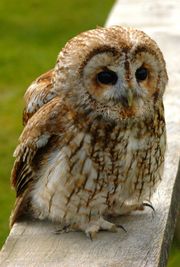
A
Tawny Owl, Strix aluco.
In many parts of the world, owls have been
associated with death and misfortune, likely due to
their nocturnal activity and common screeching call.
However, owls have also been associated with wisdom and
prosperity as a result of frequently being companion animals
for goddesses.
Henry David Thoreau summarized one perception of owls, when
he wrote in 1854's Walden, "I rejoice that there are owls. Let them do
the idiotic and maniacal hooting for men. It is a sound
admirably suited to swamps and twilight woods which no day
illustrates, suggesting a vast and underdeveloped nature
which men have not recognized. They represent the stark
twilight and unsatisfied thoughts which all [men] have."
Africa
Ancient Egyptians used a representation of an owl for their
hieroglyph for the sound m, although they would
often draw this hieroglyph with its legs broken to keep this
bird of prey from coming to life..
The Americas
In the culture of the Native Americans, (e.g. the Native
American Hopi nation), taboos often surround owls and they are
often associated with evil or sorcery. Like
eagle feathers, the possession of owl feathers as
religious objects is regulated by federal law (e.g. The
Migratory Bird Treaty Act of 1918 and Title 50 Part 22 Code
of Federal Regulations).
The
Aztecs and Mayans, along with other natives of Mesoamerica,
considered the Owl a symbol of death and destruction. In
fact, the Aztec god of death, Mictlantecuhtli, was often depicted with owls. There is
a saying in Spanish that still exists today: cuando el
tecolote canta, el indio se muere ("when the owl
cries/sings, the Indian dies").
Asia
In
Japanese culture, owls are seen as either negative or
positive symbols depending on species. Owls are seen as
divine messengers of the gods while Barn or Horned owls are
perceived as demonic figures.
In
Indian culture, a white owl is considered a companion of the
goddess of wealth, and therefore a harbinger of prosperity.
The owl has been adapted as an emblem to reflect its
implications of wisdom (Wise old owl) by a revered military
institution in India known as the Defence Service Staff
College. In colloquial use,
however, it is commonly used to refer to stupidity.
In the ancient region of Akkadia (located in present-day
Iraq), the demoness Lilith is thought to have been
associated with (screech) owls as well. However, prior to
the rise of Islam, owls were considered evil omens and bad
luck in most Middle Eastern pagan traditions. In modern times, although such
superstitions are less prevalent, owls are still popularly
considered "evil" because of their fierce, horrific
appearance.
Europe
In
Greek mythology, the owl, and specifically the Little Owl,
was often associated with the Greek goddess Athena, a bird
goddess who often assumed the form of an owl. Athena was
also the goddess of wisdom, the Arts, and skills, and as a
result, owls also became symbols of teaching and of
institutions of learning, being included in the crest of
arms of many universities. In the Western world, owls
continue to be traditionally associated with wisdom. They
are the unofficial mascot of the high-IQ society Mensa.
The
Romans, in addition to having borrowed the Greek
associations of the owl, also considered owls to be funerary
birds, due to their nocturnal activity and often having
their nests in inaccessible places. As a result, seeing an
owl in the daytime was considered a bad omen. The vampiric
strix of Roman mythology was in part based on the owl.
Likewise, in
Romanian culture, the mournful call of an owl is thought to
predict the death of somebody living in the neighbourhood.
Such superstitions caused a minor disturbance when an owl
showed up at Romanian President's residence, Cotroceni
Palace.
Owls in popular culture
References
- Paul A. Johnsgard, North American Owls: Biology
and Natural History
ISBN 1-56098-724-3, Smithsonian Institution Press,
1997
-
Bernd Heinrich, One Man's Owl, 1987
-
Bernd Heinrich, Owl in the House: A Naturalist's
Diary, 1990
External links




